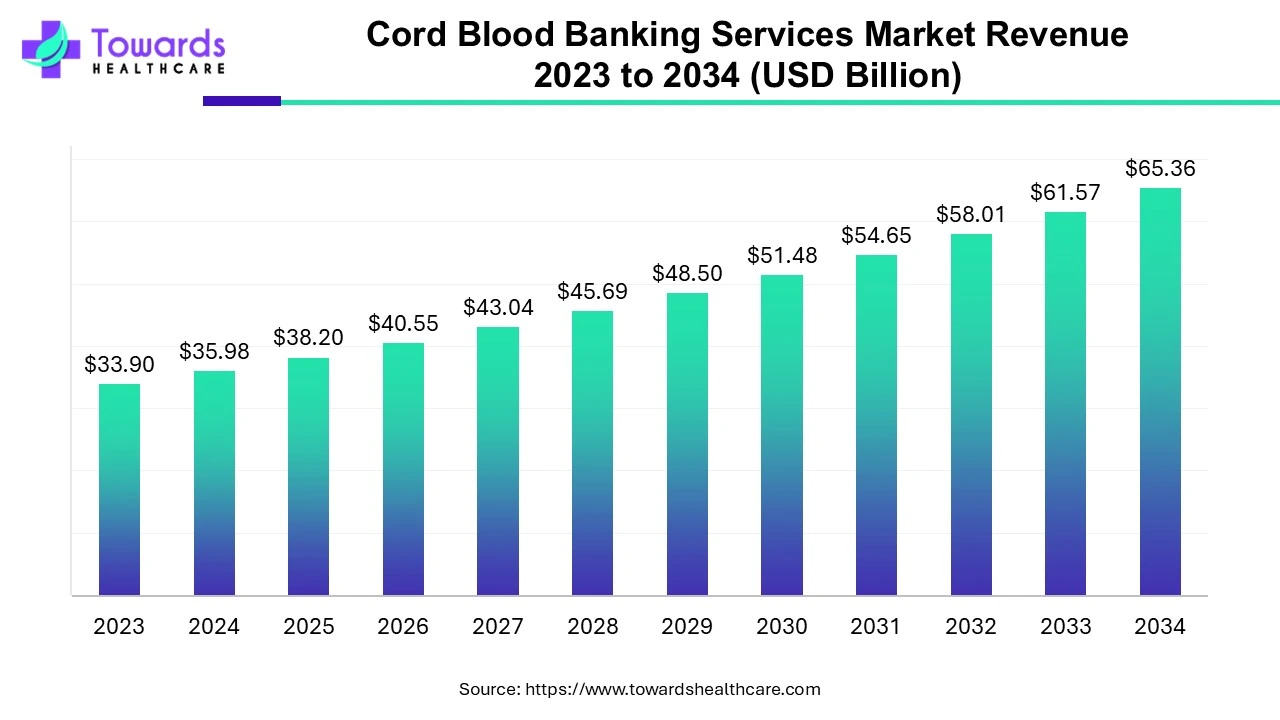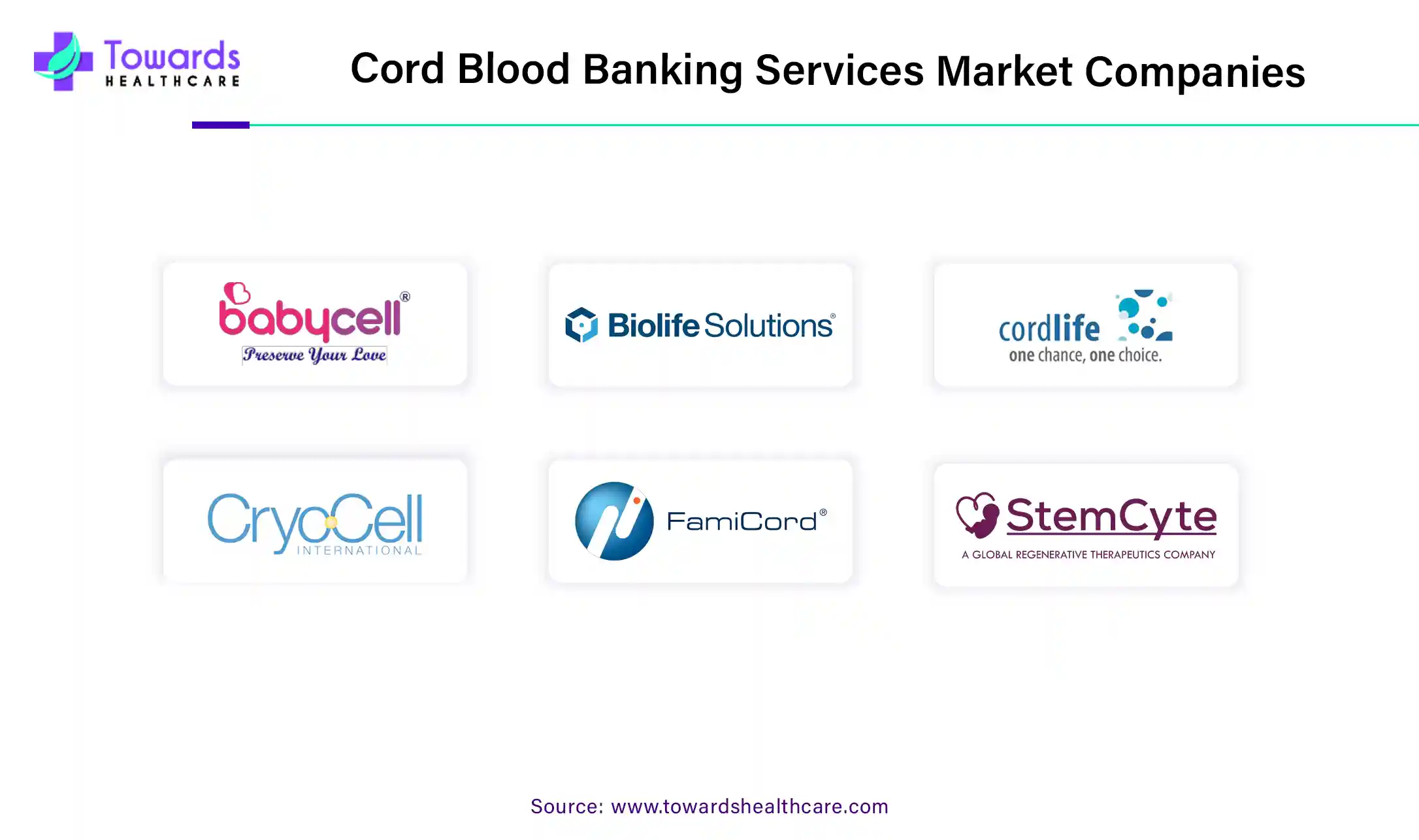March 2025


Principal Consultant

Reviewed By
The cord blood banking services market was estimated at US$ 33.9 billion in 2023 and is projected to grow to US$ 65.36 billion by 2034, rising at a compound annual growth rate (CAGR) of 6.15% from 2024 to 2034. The rising prevalence of chronic disorders, growing research and development, and increasing awareness drive the market.

Cord blood is the blood that is collected from the umbilical cord and placenta after the birth of a baby. Cord blood contains stem cells that are used to treat several disorders. Cord blood banking services include collecting, processing, and storing cord blood or stem cells in a blood bank. A cord blood bank can be either public or private. In public cord blood banks, the cord blood collected can be used by any diseased person other than a family member. Meanwhile, in private cord blood banks, the cord blood is stored for only the family member of the donor.
The rising incidences of cancer, genetic disorders, infectious diseases, hematological disorders like anemia, and immunological disorders increase the demand for stem cells. The increasing awareness for donating cord blood potentiates the market.
The awareness about the significance of storing cord blood is rapidly increasing among the population. Several government and private organizations are working towards advancing the research and increasing public awareness of cord blood through numerous awareness programs. Stem cells derived from cord blood have been studied for use in several disorders such as cancer, autoimmune, neurological, hematological, and genetic disorders. Several researchers are investigating extended novel applications of cord blood. Hence, this increased potential applications of cord blood and stem cells lead to greater awareness among new parents. The awareness is also increased through educational campaigns and partnerships with medical institutions. Moreover, digital platforms like social media and digital media play a crucial role in providing information about cord blood and its benefits, thereby promoting the market.
The major challenge of the market is the high cost of storing the infant’s cord blood in a private cord blood bank. Private cord blood banks charge an initial processing fee and yearly fees for storing stem cells. The average price of initial processing fees ranges from $1,000 to $3,000, and yearly fees from $150 to $300. This limits the affordability of many lower and middle-income groups. Another major challenge is the inadequate storage of stem cells. The cord blood containing lower volume and cell counts are discarded for not meeting processing and storage requirements.
North America held a dominant presence in the cord blood banking services market in 2023. The increasing awareness, favorable government policies, and the presence of key players drive the market. California is at the forefront with the largest cord blood market in the world. The cord blood banking rates are highest in the US, i.e., at 3% of births annually. The Canadian Blood Services reports that the chance of the need for cord blood by a child is around 0.005%, i.e. 1 in 20,000 to 0.0004%, i.e. 1 in 250,000. The total number of registered cord blood units in the US in 2022 was around 267,590. In July 2024, the US Department of Health and Human Services’ National Health Information Center designated July as National Cord Blood Awareness Month to increase awareness about the significance of saving and storing cord blood.
Asia-Pacific is projected to host the fastest-growing cord blood banking services market in the coming years. The expanding healthcare investment, increasing awareness, favorable government policies, and the increasing prevalence of chronic disorders drive the market. China is reported to perform more cord blood therapies per year than the rest of the world combined. As of 2024, nearly 40,000 cord blood transplants were performed in China alone. In India, the cord blood banking rate is 0.4% of births annually. There are a total of 14 private and public cord blood banks in India. In Japan, there are a total of public cord blood banks as of May 2024.
By storage services, the private cord blood banks segment led the global cord blood banking services market in 2023. Private cord blood banks store stem cells derived from cord blood for siblings, parents, and grandparents suffering from any chronic disorder. The stem cells from the donor need not be assessed to check their matching with the receiver, as they are stored only for the family members.
By storage services, the public cord blood banks segment is expected to grow at the fastest rate in the market during the forecast period. Public cord blood banks follow strict quality assurance and FDA regulations. The segmental growth is attributed to its affordability, stringent regulatory guidelines, and increasing awareness.
By component, the cord tissue segment dominated the cord blood banking services market globally in 2023. Cord tissue contains blood vessels supported by tissue called Wharton’s jelly, which is a rich source of mesenchymal stem cells. Cord tissue can treat a wide range of diseases by regenerating within the body.
By component, the cord blood segment is anticipated to grow with the highest CAGR in the market during the studied years. Cord blood is the blood that remains in the placenta and umbilical cord after the birth of the baby. The US FDA has approved cord blood for more than 80 different conditions in humans.
By application, the diabetes segment registered its dominance over the global cord blood banking services market in 2023. The rising prevalence of diabetes and growing research for cord blood-derived stem cells for type-1 diabetes augment the segment’s growth. The cord blood stem cells can keep the immune system in balance.
By application, the cancer segment is projected to expand rapidly in the market in the coming years. The increasing incidences of cancer and the complexity of the disease boost the market. This demands novel treatment strategies, potentiating the use of stem cells for cancer treatment.

Mr. Mayur Srisrimal, CEO & Managing Director, LifeCell International, India’s largest cord blood bank, in an interview, demonstrated that the cord blood banking market in India is rapidly growing, owing to a substantial increase among parents and the introduction of affordable pricing plans. He also added that there is a shift toward hybrid banking models benefitting both the children and the parents.
By Storage Services
By Component
By Application
By Region
March 2025
February 2025
January 2025
December 2024